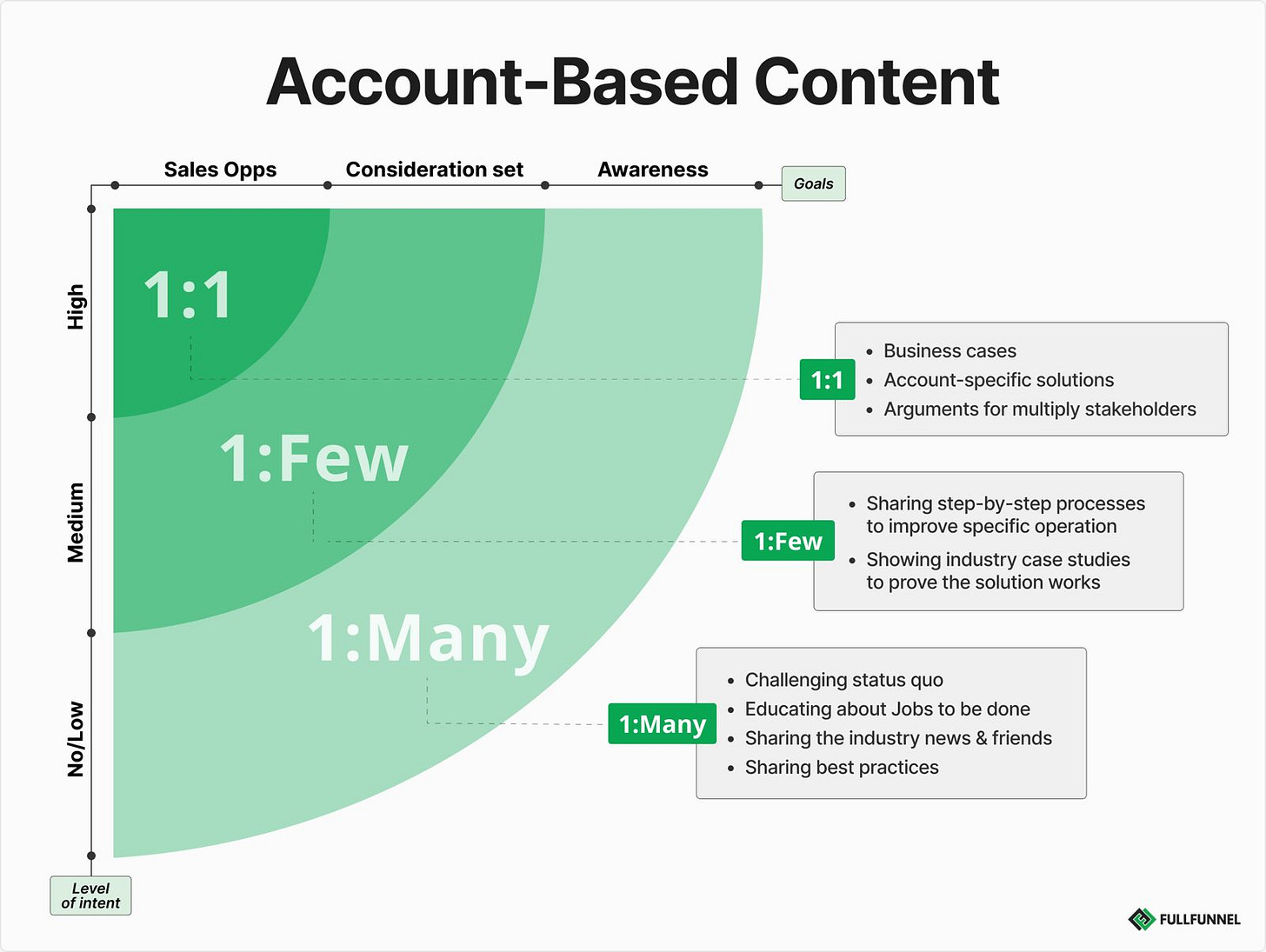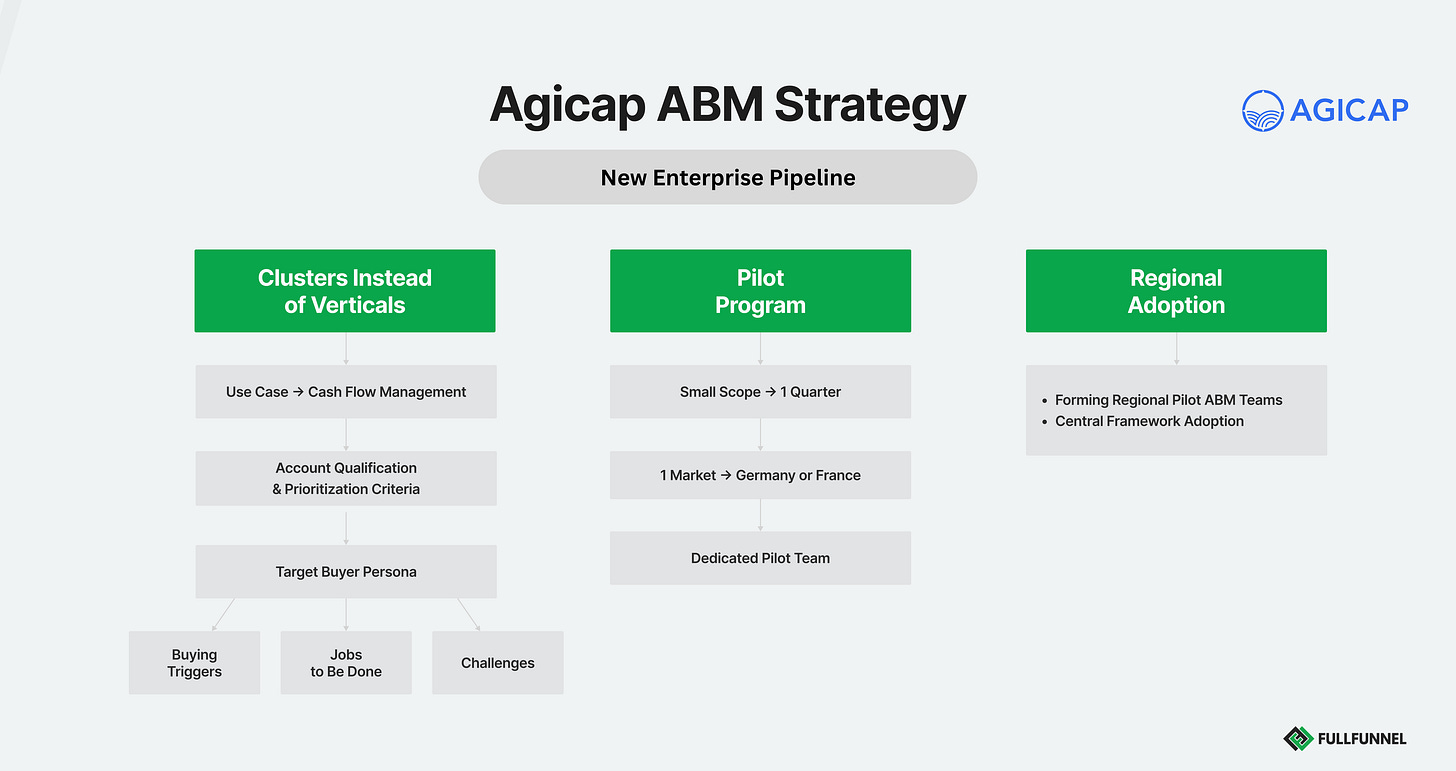🕵🏻♂️ Account-based content
How to influence accounts at different stages of their buyer journey
From my humble opinion, content is the most undervalued but crucial factor for ABM success. B2B companies often treat this as a “nice-to-have, low-impact activity”:
Creating superficial content in ChatGPT, asking AI to pretend as a buyer persona
Publish white papers that tell how miserable their buyers are with current processes and how their software will magically sweep away all business challenges (assuming that everybody who reads it is ready to buy).
While the reality is opposite.
Most of your target accounts are not actually buying or considering any product. Successful ABM is, in most cases, about change management, which you can't initiate until you are a "known" vendor.
Today I want to share:
Here is how we create an Account-Based Content Strategy
How we increased our win rates to 50% with 1:1 content
Live case study - How we implemented account-based content strategy at Certn
GET ACCESS TO A NEW FULL-FUNNEL ABM 2.0 COURSE
What's included with the course access:
12 modules covering step-by-step ABM strategy development: goal decomposition, ICP, account list building, ABM team, warm-up and activation playbooks, reporting, scaling ABM and building a cohesive ABM & demand gen function.
Short explanation videos and "how to" examples. We believe it's better one time to see a practical example then listen to the theory hundreds of times.
5 orchestrated and ready-to-use ABM playbooks and a detailed explanation
Report dashboard for 4 types of ABM programs: new revenue, pipeline acceleration, expansion and churn prevention
Live case studies and examples of the campaigns we implemented with the clients of Fullfunnel.io in the past few years
17 templates to simplify your ABM strategy launch: ICP, revenue analysis, intent data tracking, account warm-up cadence, customer research, account scoring and prioritization, ABM budget planning and forecasting, account planning, reports, personalized offers, and many more.
Planning & Presenting a Pilot ABM Program to Execs and Sales Framework
Minimal viable stack recommendation and guidelines on how to use it to avoid ramping up budget and being pressured to show ROI for the purchased $50k software
Here is how we create an Account-Based Content Strategy.
1:MANY CONTENT.
The goal of our strategy is to create awareness with:
Challenging the status quo of inefficient processes or biases about "how things should be done"
Sharing the best practices to refine the jobs-to-be-done for the target buyer persona
Sharing the industry news and trends
We target the entire ICP cluster, accepting the fact that most of them are not in the market now and there is no buying intent.
This newsletter and our LinkedIn content are best examples.
1:FEW CONTENT.
The goal is to generate demand and get into the consideration set.
We pick up certain operations and processes where a target buyer persona usually experiences the challenges and describe step-by-step solutions for them.
We don't push the product, but, on the contrary, explain first why and how their processes should be improved. Technology, logically, becomes a central part of it.
To prove the concept, we use specific use cases or customer stories.
The level of intent is medium, and these accounts could become a future pipeline.
Below is an example of the content I recently wrote for Agicap (which can resonate with a few companies that experience similar challenges).
Drive pipeline THIS quarter with full-funnel ABM programs.
If any of these challenges sound familiar:
You are aligned in theory with sales but don’t do anything in practice aside from receiving wish lists from sales and sharing with them your marketing plan. In reality, you work in silos and miss the revenue targets and are being pressured by your executives.
You understand that your marketing and sales playbook is broken (mqls, gated content) but despite many attempts you don’t know how to fix it
Your outbound, paid ads and organic pipeline drastically decreased while CAC increased mostly because most of your market is problem unaware and not buying.
You lack brand awareness among target accounts and sales can’t get even a reply.
You clearly see that you're already behind your revenue targets
We can help.
We'll develop a custom full-funnel ABM strategy aligned with your resources, budget and stack and execute it together to drive results THIS quarter.
Here is how I'd optimize the new enterprise pipeline ABM strategy for multi-regional B2B tech company like Agicap.
1. CLUSTERS INSTEAD OF VERTICALS.
Agicap's "bread and butter" use case is cash flow management, which could be applicable to companies from many verticals.
With vertical-based ABM programs you need multiple ABM teams to cover all verticals, while the needs of different accounts in the same vertical might vary.
With a cluster (use case) targeting, you can define unified account qualification criteria based on typical use case challenges and buyer triggers.
As a result, Agicap can create more relevant messaging and content for a specific set of accounts.
2.SET UP A SMALL-SCOPED PROGRAM EITHER IN GERMANY OR FRANCE.
Starting small in the market where you have a historical success is vital for ABM scaling.
First, you can collect wins faster.
Second, you're more likely to demonstrate enterprise pipeline results faster because of brand awareness.
Small-scoped team should include:
- ABM lead - 80% of the time.
- Account-based SDR with at least 8 months in the position who was fully onboarded and has a domain knowledge - 60% of time.
- Content marketer to execute an account-based content strategy - at least 40% of time.
Operational support should also come from:
- Subject-matter expert with deep understanding of cash flow management in multiple verticals. Ideally, a person who spent years in the same position as the target buyer persona.
For companies like Agicap it's essential because their targeting varies from CFOs and finance managers to CEOs of SMBs. All these roles have different jobs-to-be-done, KPIs and business challenges that can trigger their buying process.
- RevOps who'll integrate Hubspot with other stack that supports ABM program: intent data, field events and webinar sign-ups, content downloads, etc. This person should also maintain ABM lists and provide fresh updates for ABM team to plan the next account development actions.
- Field events + demand generation team.
3. DEVELOP AN INTERNAL CENTER OF EXCELLENCE.
The pilot ABM team should become an internal center of excellence to implement a central framework for other regions and teams.
Quite often, the companies that were growing 2x every year, try to maintain the growth with the regional expansion (Agicap started an expansion in Spain and UKI).
The problem with the regional expansion though is that the regional teams often operate in silos and deal with completely different GTM challenges:
Lack of brand awareness, stronger local competition, etc.
If the central ABM framework is not adjusted to the regional reality and nobody supports the regional team, the program is doomed.
ABM requires a thorough cross-functional collaboration that evolves from small-scoped pilot program. The pilot team then takes it to the next level by operationalizing and adjusting the strategy for other regions and clusters.
1:1 (ONE:ONE).
We create fully personalized content for a specific account, including:
Detailed business cases
Arguments for different stakeholders
Account-specific recommendations and solutions
We want to accelerate the sales cycle and influence the purchase decisions of the accounts with high intent.
In Q4 2024, we increased our win rate to 50% from all qualified inquiries because of these tweaks in 1:1 account-based content. Here is what we did.
1. BEFORE THE DISCOVERY CALL.
We analyzed all sales calls we had in 2023-2024 and extracted all questions our prospects asked us.
For every type of question (How we'll work together? What can we expect from the pilot ABM program?) we created a separate deck with clear answers and examples.
Next, we transcribed all live case studies with our customers and added a short summary for each case study, with a link to the full interview, and categorized them by vertical and use case.
Depending on the inquiry, we were adding additional content to prepare our prospect for the call.
For example:
- What stack do I need?
- How to get buy-in from sales?
We sent the content hub before the call and asked to review it before our chat.
2. AFTER DISCOVERY.
For the discovery call, we've updated our questionnaire using best practices from Nate Nasralla and Jen Allen-Knuth. The entire discovery was focused on extracting:
a) The buying trigger and why it's important to launch an ABM program now.
We focused on what's going on, the root challenges, and what will happen if the company doesn't solve them (the cost of inaction).
b) Competing priorities.
Is there anything else that could distract an ABM pilot team from the execution?
c) Competing priorities leader.
Who has a different opinion on how the company's challenge should be solved and why?
d) Current marketing and sales setup and skillset.
e) What do we need to get program approval?
After a discovery call, we prepared a detailed business case and additional content for our Champion to facilitate internal conversations and explain to the leadership why they need an external partner.
We updated the entire content hub, including example program timeline, metrics, resources, and stack, + what we can expect from the pilot.
As one of our clients said:
"All I needed was to make a few screenshots from your deck to present everything to my leadership".
TLDR;
To generate and win enterprise sales opportunities, you need to have a healthy mix of 1:many, 1:few, and 1:1 content.
Whenever your ABM team starts any engagement with the target account, you must immediately switch to 1:1 fully personalized content.
Understand what questions your Champions might have before even talking to you.
Understand what internal conversations your target buyers might have.
Create content that addresses the issues that the entire buying committee might have, and update your collateral with every insight collected.
This is ABM 101.
Listen to Full-Funnel Live - Account-Based Content
*If you want to attend the next live episode, sign up here to receive an invite. Usually, we host them every Wednesday at 4 pm CET (Central Europe) - 10 am ET (Eastern Time).
In the new episode of Fullfunnel Live we’ll share a step-by-step case study on mastering account-based content marketing with insights and actionable strategies.
We invited our client, Ellen Kaross, a Global Marketing & Communications Manager at Certn, to share:
How to support account-based marketing strategy with content
How to create account-specific content and support sales reps
How to combine brand content strategy and account-based content
Subscribe to Full-Funnel podcast:





